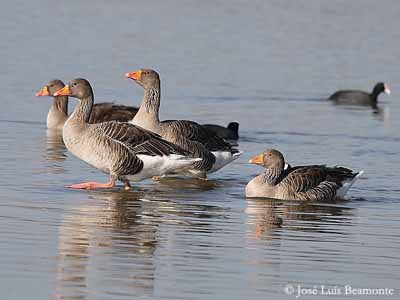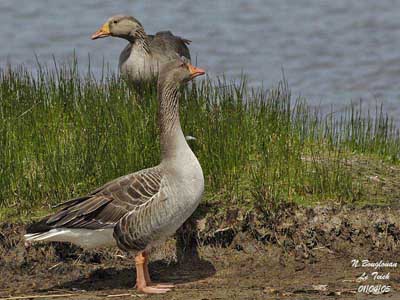
Fr: Oie cendrée
All : Graugans
Esp : Ansar Común
Ital: Oca selvatica
Nd: Grauwe Gans
Sd: Grågås
Photographers:
José Luís Beamonte
Pájaros de España
Steve Garvie
RAINBIRDER Photo galleries
Niraj V. Mistry
Photo Galleries
Nicole Bouglouan
PHOTOGRAPHIC RAMBLE
Text by Nicole Bouglouan
Sources:
HANDBOOK OF THE BIRDS OF THE WORLD vol 1 by Josep del Hoyo-Andrew Elliot-Jordi Sargatal - Lynx Edicions - ISBN: 8487334105
ENCYCLOPEDIE DES OISEAUX DE FRANCE ET D’EUROPE – de Peter Hayman et Rob Hume - Flammarion – ISBN : 2082009920
GUIDE DES CANARDS, DES OIES ET DES CYGNES – de Steve Madge - Delachaux et Niestlé - ISBN: 2603013769
L’ENCYCLOPEDIE MONDIALE DES OISEAUX - Dr Christopher M. Perrins - BORDAS - ISBN: 2040185607
THE COMPLETE BOOK OF BRITISH BIRDS – Written by “Royal Society for the Protection of Birds” experts - Préface de Magnus Magnusson - Michael Cady- Rob Hume Editors - ISBN: 0749509112
THE HANDBOOK OF BIRD IDENTIFICATION FOR EUROPE AND THE WESTERN PALEARCTIC by Mark Beaman, Steve Madge - C.Helm - ISBN: 0713639601
Pájaros de España (JL Beamonte)
Greylag Goose
Anser anser
Anseriforme Order – Anatidae Family
BIOMETRICS:
Length: 76-90 cm
Wingspan: 147-180 cm
Weight: 2500-4100 g
DESCRIPTION:
The Greylag Goose is an Old World species and the ancestor of most of the domestic geese. It is the largest goose of the grey species.
Adult has bulky body with greyish-brown plumage, with creamy-white edges on the upperparts, and blackish flight feathers. The white tail is rounded with only one black bar.

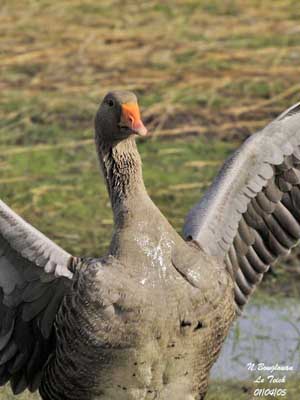
On the pale brownish underparts, we can see fine greyish-brown spots or blotches. Flanks are rather brown with pale feather’s edges. Underwing is white and grey with darker flight feathers. Belly and undertail coverts are white.
Head and neck are greyish-brown.
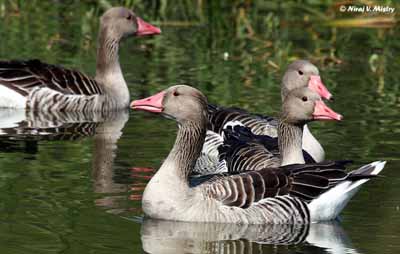
Both sexes are similar.
Juvenile usually has more irregular bars on the upperparts and duller plumage.
VOICE: SOUNDS BY XENO-CANTO
The Greylag Goose utters flight-calls such as loud, honking series of notes with repeated deep “aahng-ahng-ung”. When in flocks, the noise is audible at some distance.
This goose produces deeper and more ringing sounds than other grey geese.
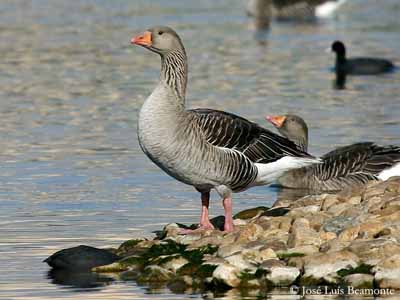
HABITAT:
The Greylag Goose frequents wet areas with open country, near grasslands or with fringe vegetation.
During winter, this species is found in swamps and cultivated areas in open country, and also in lakes and lagoons.
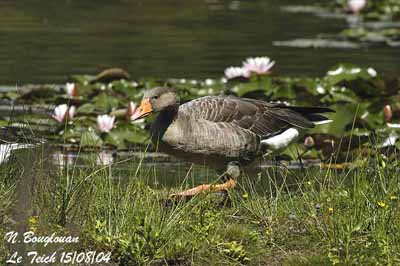
RANGE:
The Greylag Goose is an Old World species, but some feral and domestic geese occur in North America.
The race “A.a. anser” is found in Iceland, N and C Europe.
The race “A.a. rubrirostris” is found from Turkey and URSS to NE China.
There are some sedentary populations, but most of them move southwards to winter at lower altitudes. Numerous birds winter in Spain, especially in the marshes of Doñana, in Andalucía.
Other movements occur, according to the ice expansion during hard winters.
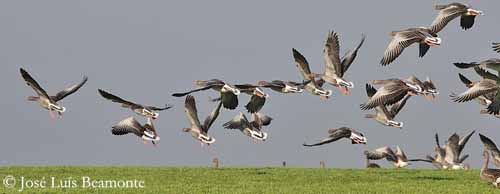
BEHAVIOUR:
The Greylag Goose is mainly vegetarian, feeding on various plant items such as grass and leaves, roots, stems, fruits and sprouts of numerous plants’ species. During winter, it also takes grain and vegetables.
They forage by grazing on the ground or in water where they perform “upending” as ducks.
These geese are often seen in flocks and are gregarious. They usually feed and roost together outside the breeding season. Even courtship displays take place in groups, and they may nest in loose colonies.
To live in flocks also reduces the risk of predation, and to find food is easier for each goose.
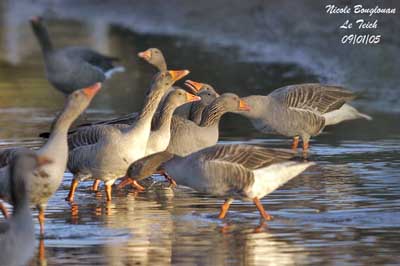
In order to keep the group united, some specific criterions are necessary to maintain visual contact between them. Some difference may involve attacks or chases from individuals against other birds, as displayed in the following photograph.
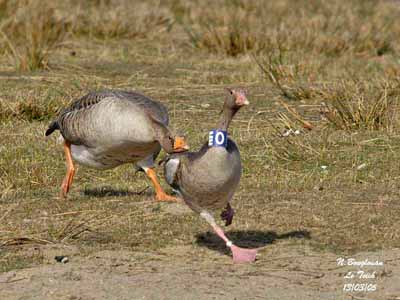
A ringed goose of race “rubrirostris” spent some days in the area where several geese of race “anser” were living. This “intruder” with different appearance has been regularly chased away from the place by the local geese. These postures are used to keep individual distance and to defend the territory.

The Greylag Geese usually remain paired for life, but the territory is not maintained all year round. Most of juveniles remain with adults until the next spring and breeding season. The young often spend the summer of their second year in their native territory, and may help in defence and rearing of the chicks.
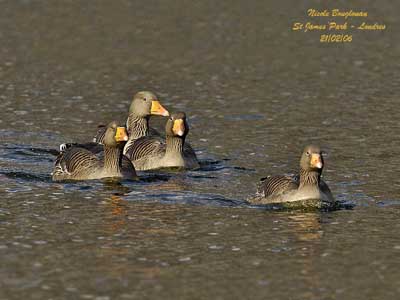
FLIGHT:
The Greylag Goose needs to run over the water surface to take off, due to its heavy and bulky body, and it flies very well thanks to the strong wings. The goose has to perform continuous fast wing-beats to maintain the direct flight. When flying in flocks, usually the oldest leads the group.
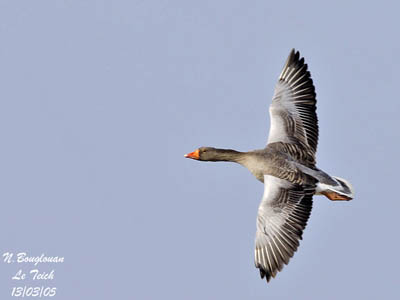
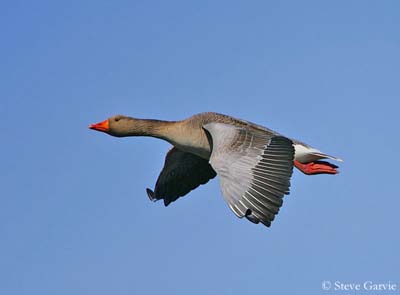
They land onto the water after descending legs first, gliding over some distance on the surface before to stop.
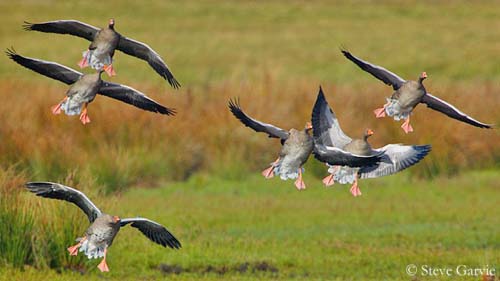
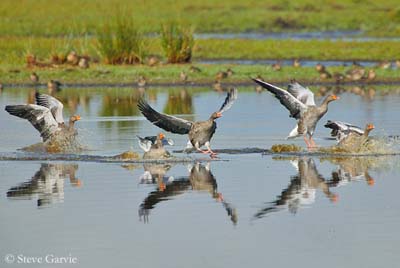
REPRODUCTION:
Breeding season starts in March-April.
The Greylag Goose often nests in loose colonies. The nest is built by both adults, and can be placed on the ground or sometimes in trees. It is a shallow cup made with reed stems and grass, and lined with down. When placed on the ground, it is usually concealed among reedbeds.
The female lays 4-6 eggs. Incubation lasts about 27-28 days. The chicks are precocial. They are covered in brownish-olive down on the upperparts, and yellow below. They fledge about 50-60 days after hatching. They reach the sexual maturity at 2-3 years.
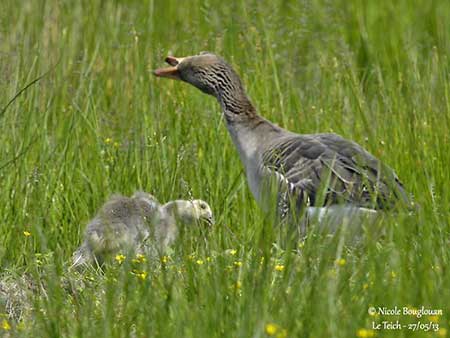
DIET:
The Greylag Goose feeds mainly on plant items such as leaves, grasses, roots, fruits and sprouts. During winter, they favour grain, potatoes and various vegetables.
The typical bill is adapted for grazing in grassland, and probing in marshes to reach roots and bulbs.
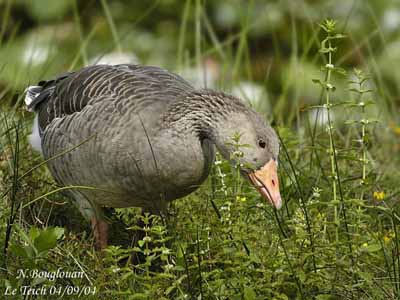
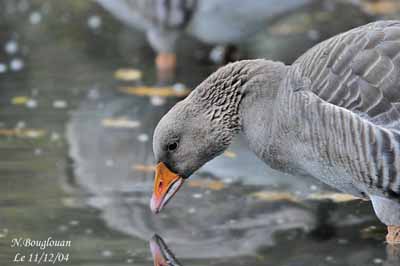
PROTECTION / THREATS / STATUS:
The Greylag Goose is not threatened at this moment, but the drainage of wetlands and the heavy hunting pressure caused several declines.
In addition, this species causes crop damage, involving conflicts with farmers.
Several reintroductions occurred successfully in some areas.
